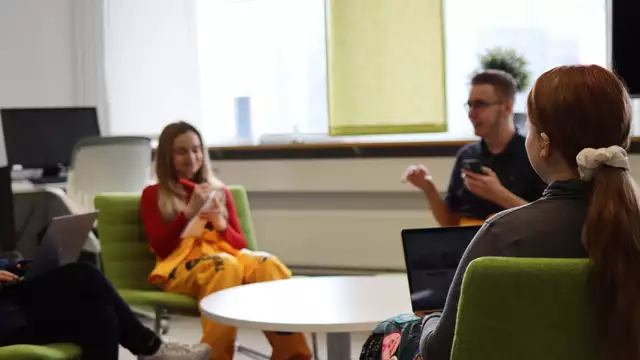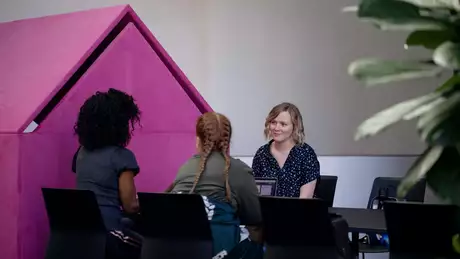
Students as Change Agents for regional and local organisations – An example from a Nordic-Baltic circularity initiative for the textile industry
Published: 24.09.2024 / Publication / Blog
In this blog post we describe how we approached the task of coming up with or designing circular solutions for a client in the textile industry.
Background
The clothing and textiles sector matters for global and local economies, representing millions in jobs and US$1.5 trillion in revenue. It, however, struggles to address its contribution to climate change, nature loss and pollution (UNEP, 2024). The textile and clothing (T&C) sector is moving towards circular business models (CBMs) to tackle its significant environmental impact. This change is driven by the industry's recognition of its contribution to environmental harm and the pressing need for sustainable practices. One of the significant challenges faced by companies in the T&C industry is the path dependencies shaped by their existing business models and supply chain positions. When designing solutions, it’s crucial to consider a client’s control within their supply chain. This means understanding where they have leverage points to implement changes effectively is crucial (Salmi & Kaipia, 2022).
One objective with the initiative IP CHARLO (Change Agents for regional and local organisations), an intensive programme financed by the Nordplus Higher Education, was to educate and involve students in concrete work with sustainability and community resilience in the different regions across the Nordic and the Baltics. Another objective was to introduce novel sustainable solutions to a client company in the textile industry - Moomoo, in Estonia. At the same time the initiative strengthened networking in our EkoTekNord network as well as enhances learning between universities and companies in the selected region. In total 40 students representing Finland, Estonia, Sweden, Latvia, Lithuania, Iceland, Denmark, and Norway, were part of the IP CHARLO team.
Sustainability and circularity
The transition to a circular economy (CE) model is a more sustainable alternative discussed for decades with different concepts and thinking. The core goal of CE is to use resources continuously as a closed circulation chain, where even waste is maximised (Ellen MacArthur Foundation, 2019). In other words, instead of throwing away old products, CE encourages recalling them for reuse, repair or recycling into new finished products (WEF, 2023).
To implement CE, innovation is needed in manufacturing, design, business models, organisational systems and supply chains (European Commission, 2020). CE's principles include: Carrying out closed cycles, maintaining materials in circulation as long as possible, ensuring the value of materials and products, etc. (Bocken et al, 2016). Without urgent and focused action to change the way resources are used, material resource extraction could increase by almost 60 % from 2020 levels by 2060, from 100 to 160 billion tones and this is far more than what is need to fulfil the needs of humans according to the SDGs (Global outlook report, UNEP, 2024 External link).
Shifting from a linear to a circular business model requires significant cultural and organisational changes. Companies need to break away from traditional practices and embrace new ways of thinking and operating. This involves fostering a culture of innovation, collaboration, and continuous improvement throughout the organisation (Salmi & Kaipia, 2022). Furthermore, improvements in product planning and design are essential, focusing on dematerialisation, environmentally friendly materials, product longevity, ease of maintenance and repair, and circular design principles. By prioritising these aspects, companies can create products that are not only environmentally sustainable but also economically viable and socially responsible. (Wilson-Powell, 2021)
Designing circular solutions should involve a thorough analysis of the client’s product portfolio to identify suitable CBMs. This includes assessing materials used, manufacturing processes, and end-of-life strategies. By identifying opportunities for circularity, companies can optimise resource use and minimise waste generation. (Grant et al, 2021; Ellen McArthur; Foundation, 2024). Our focus is on the textile industry and worldwide 25% of the produced synthetic chemicals are used to make textiles on top of this only 20% (approx.) of the discarded clothes are reused or recycled (Wilson-Powell, 2021). In the following, we describe how we approached the task to come up with or design circular solutions for the client in the textile industry.
Working with design thinking and the circular canvas
Our approach as change agents in IP CHARLO was based in design thinking and a main tool for us in the work has been the circular canvas (Circulab, 2024, Figure 1). Throughout the week in Estonia worked according to design thinking principles (Lewrick, Link & Leifer, 2020) which means that a user (client) centeredness and research mindset were crucial. Inspired by the double diamond (Design Council, 2024), we knew to focus on the problem for the first part of the week and for the latter part of the week the focus was on finding solutions. Our other starting point was our insights and learning about circularity. Here the value hierarchy (Grant et al, 2021) guided us in the understanding of which actions are the most sustainable and that is the reduce level: reduce material, reduce buying, reduce energy etc.

The client company, Moomoo External link, caters primarily to clubs with made-to-order items and white-label products for partners in Norway and Latvia, and has seen a significant rise in online sales. Moomoo has an 80% cutting efficiency and addresses waste issues promptly. Their sustainability initiatives include KIUD Packaging for online customers, a prototype repair service etc. With a 2022 carbon footprint of 170 tons of CO2, mainly from transportation, Moomoo aims to improve sustainability and circularity. Moomoo presented us with the problem of aligning their business model with circular economy principles while effectively communicating these changes internally and externally. Our days in Tartu were filled with lectures, workshops, and visits to Moomoo's factory, providing us with invaluable insights into the company's operations and sustainability challenges. By employing the Circulab’s toolkit, encompassing elements like the circular canvas, value chain canvas, partner map, and problem matrix, we managed to elaborate on the problem and come up with novel circular solutions for the client by the end of the week.
Results and suggested solutions
A number of opportunity areas and their possible solutions were identified by our student teams and presented to Moomoo. See figure 2.

Next, we present a few long- and short-term solutions suggested by the teams.
Waste Control
Using cut pieces in developing reusable packaging bags for Moomoo products, using cut pieces in developing other textile products such as cushion covers, laundry bags or even wrist bands etc., and using small cut pieces as filling of stuff toys, pillows etc. To increase the lifespan of products in terms of reuse concept, the teams recommended a post-sale retail exchange scheme, where Moomoo could offer customers to exchange used products in good shape to get subsidy on purchase of new Moomoo products. These used products in good shape would then be repaired, cleaned, and resold by Moomoo for a reduced price on Moomoo secondhand platform. To foster recycling concepts, the teams suggested offering customers to return unusable products.
Opportunities in Design Phase
Some teams suggested replacing elastane also known as Lycra (elastic material used in the Moomoo fabric) with an eco-friendlier alternative or at least a bio-based elastane. Teams argued it to be a cheaper and bio-degradable option that could eventually be converted into renewable energy.
Inhouse Recycling Facility
Having Moomoo’s own recycling process to have the material recycled in house is yet another workable solution offered by the study teams.
Moomoo as a Sustainable Tourist Attraction
One of the teams even suggested redeveloping Moomoo’s production facility into an absolute carbon neutral and sustainable factory and shared a model facility layout. They argued that the facility could be a Tourist Attraction Place due to its sustainable design in terms of energy consumption, reuse, and recycling strategies.
Conclusion
The collaborative efforts of all the students in the Nordplus IP CHARLO have developed key insights into sustainable solutions within the context of the circular economy, with a particular focus on solutions for Moomoo. Through a diverse blend of expertise, backgrounds, and perspectives, we as participants engaged in a comprehensive exploration of sustainability challenges and opportunities, guided by the principles of sustainability, circularity, social responsibility, and economic viability.
Within the context of Moomoo's operations, we identified multifaceted opportunities for enhancing sustainability across various facets of the business model. Strategies encompassed waste control measures, innovative design approaches, in-house recycling facilities, and the transformation of Moomoo's production facility into a sustainable tourist attraction. These recommendations reflect a commitment to maximising resource efficiency, minimising environmental footprint, and fostering positive social impact.
Our experience in Tartu and Tallinn exemplified the power of interdisciplinary collaboration and collective problem-solving in addressing sustainability challenges. For this both the both the design thinking (Lewrick et al, 2020) and the Circulab (2024) tools worked well Through structured lectures, hands-on workshops, and collaborative discussions, we were able to develop actionable solutions with an integrated the value hierarchy thinking (Grant et al, 2021), that not only benefit Moomoo but also contribute to advancing the principles of the circular economy.
Christa Tigerstedt Principal Lecturer in Business at Arcada,
Phuong Hoang, Arcada student
Saad Khan, Arcada student
Salomi Ranasinghe Padige, Arcada student
Asama Ranasinghage, Arcada student
Mahika Raj, Arcada student
Maximilian von Renteln, Arcada student
References
Bocken, N. M., et al. (2016). A literature review on the circular economy: policy, research and business perspectives. Journal of Industrial Ecology, 20(2), 261-270.
Business Finland (2019). Why Finland’s running circles around us. 5.03.2019. https://www.oecd-ilibrary.org/docserver/8a9348a4-en.pdf?expires=1716822614&id=id&accname=guest&checksum=372828AD8B6E3B2C0B0F5F220EF74369 External link
Circulab (2024). Circulas canvas tool. www.circulab.com External link. Accessed: 27.4.2024.
Ellen McArthur Foundation (2024). https://www.ellenmacarthurfoundation.org/circular-economy-opportunity-and-benefit-factsheets External link. Accessed 1.8.2024.
Grant, D., Trautrims, A. & Wong, C. (2021). Sustainable Logistics and Supply Chain Management. London: Kogan Page.
Kyrkou, D. & Karthaus, R. (2011.) Urban sustainability standards: Predetermined checklists or adaptable frameworks? Procedia Engineering, 21, pp. 204–211.
Lewrick, M., Link, P. & Leifer, L. (2020). The design thinking toolbox. London: Wiley.
Moomoo (2024). https://moomoo.ee/ External link Accessed 27.4.2024
European Commission. (2020). Circular Economy Action Plan: For a Cleaner and More Competitive Europe. https://ec.europa.eu/environment/circular-economy/index_en.htm External link
Morris, A., Zuo, J., Wang, Y. & Wang, J. (2018). Readiness for sustainable community: A case study of Green Star Communities. Journal of Cleaner Production, Vol, 173, 1 February 2018, pp. 308-317.
Rizos, V., Tuokko, K. & Behrens, A. (2017). The Circular Economy -A review of definitions, processes and impacts. CEPS research report.
Salmi, A. & Kaipia, R. (2022). Implementing circular business models in the textile and clothing industry. Journal of Cleaner Production, 378, 134492. https://doi.org/10.1016/j.jclepro.2022.134492 External link
Taylor, B. (2021). Closing the loop on take, make, waste: Investigating circular economy practices in the Swedish fashion industry.
https://www.sciencedirect.com/science/article/pii/S0959652621004650 External link
UNEP (2024). Annual report 2023. Accessed: 15.5.2024.
UNEP (2024). Governments call for a Global Textiles Policy Dialogue. Technical Highlight. Accessed: 15.5. 2024.
World Economic Forum (2023). What is the circular economy, and why does it matter that it is shrinking? Accessed 15.5.2024.
Wilson-Powell, G (2021). Is It Really Green? London: Penguin Random House Company.


